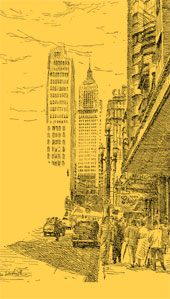 Illustrations Jan Eckschmidt/reproductions from the book "São Paulo no limiar do seu quinto século"
Illustrations Jan Eckschmidt/reproductions from the book "São Paulo no limiar do seu quinto século"Avenida São João, in São Paulo, 1955: expanding metropolisIllustrations Jan Eckschmidt/reproductions from the book "São Paulo no limiar do seu quinto século"
An international study led by physicists from the United States has resulted in new concepts and mathematical formulas that explain how cities grow. Conducted by a group which includes Brazilian physicist José Soares de Andrade Jr., from the Federal University of Ceará, the study indicated that on average small towns and medium sized cities grow proportionally faster and more than big cities and show higher growth variations between themselves: two similar medium sized cities with the same population can have entirely different destinies many decades later: one gaining more people and spreading out and the other remaining stagnant. Big cities grow in a more uniform manner, fluctuating less in relation to average growth.
These results contradict Vibratos law on urban demographic growth, according to which all cities grow the same, no matter what size. This may result in socio-political implications, says Andrade, one of the authors of the study that details these findings in the December 2 issue of PNAS magazine. “Because of these variations on the growth of the population, which is much higher in smaller cities, the study suggests that an investment plan in small cities would be subject to more risk than in a big city,” he says.
The team coordinated by Hernán Makse from New York University, created a method to study the growth of cities. Initially, the physicists applied square grids with different-sized units – or cells – over three areas that differed considerably one from the other. The first area was Great Britain, with nearly 200 thousand square kilometers (km2) and 60 million people, covered by a grid with 5.7 million 200-square meter cells (m2). The second chosen area was the United States from coast to coast, with 7.4 million square kilometers and 303 million people, divided into 59.4 million 2 square-meter cells (2 km2). The third area was even wider: 53 African countries, with 30 million square kilometers and 933 million people, covered by 500 thousand 7.4 km2 cells. The physicists applied the grid in two instances – the beginning of the 1980’s and the 1990’s, in the case of Great Britain, for example – and had the computer calculate the population variations in each cell by means of a numerical technique called CCA algorithm. This algorithm, which they created, provides the population growth rate and the cities’ expansion, aggregation or division movements.
“The average growth of cities declines in proportion to cities growth,” says Andrade, who came back to Fortaleza last month, after having worked for seven months at the Federal Polytechnic School/ ETH in Zurich, Switzerland. The fact that there is no typical value for the growth of cities characterizes what physicists refer to as power law, without regularities and clear variations such as the height of people, whose height is an average 1.65 meters, give or take 20 centimeters. One of the consequences of the power law revealed in the study are the long-reach correlations: the growth of cities of any size can influence the growth of far-away cities.
“Can the city and urban expansion be analyzed by this kind of typically positivist approach?” questions demographer Roberto Luiz do Carmo, a researcher at the Center for Population Studies/Nepo of the State University of Campinas/Unicamp. “I have the impression that this is not necessarily so. I wonder if cities in Africa can be analyzed in the same way as cities in the United States?” Cities, he points out, reflect stories and social occupation processes of own spaces. “The growth of medium sized cities followed the creation process of the big Brazilian metropolises, yet they have typical Brazilian urbanization aspects, such as the occupation of spaces that are not contingent to the urban center, with the specific objective of increasing the value of the empty spaces.”
The physicists’ study was conducted at a time when the urbanization phenomenon in Brazil and other countries is taking on new demographic and morphological patterns, granting space to more dispersed urban agglomerations, says geographer Maria Encarnação Sposito, a professor at Paulista State University/Unesp in the city of Presidente Prudente. “Expanded urbanization may be the explanation for the fact that smaller cities grow more,” adds Maria Encarnação, coordinator of the Researchers’ Network on Medium Sized Cities/ReCiMe, which comprises representatives from 14 universities in Brazil, two in Argentina and one in Chile. “From the morphological point of view, current urbanization is characterized more by the set of flows than by territorial continuity,” she says, pointing out that in the city of São Paulo, for example, there are more bus routes traveling to the city of Campinas, which lies 100 kilometers away from the capital city, than to outlying neighborhoods such as Jardim Ângela.
Republish